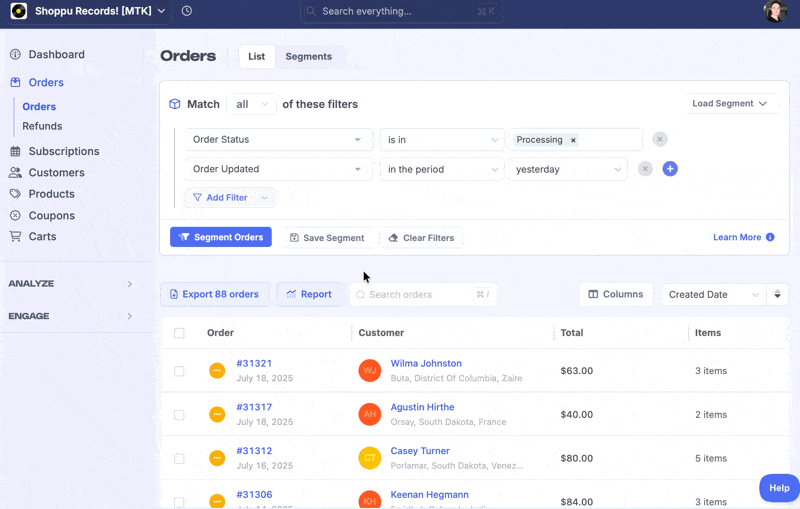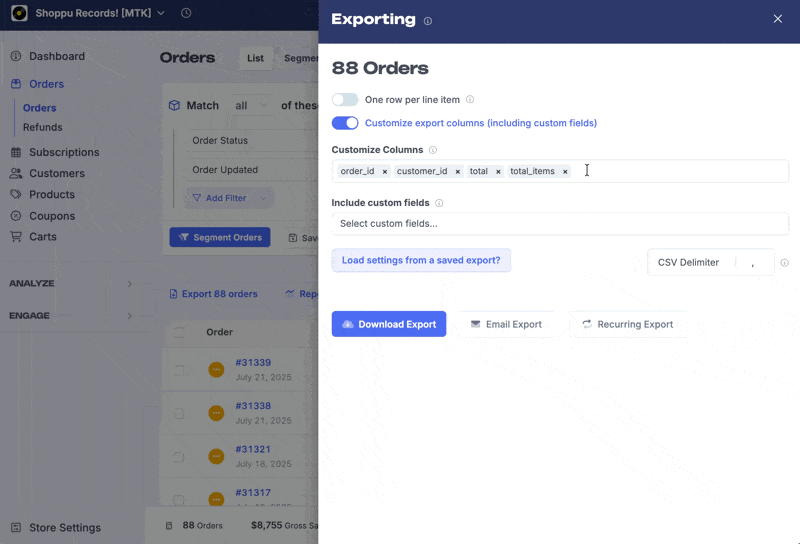Exporting Data
Metorik's exporting feature combined with segmenting makes it incredibly easy to get the data you need when you need it – and even automatically!
You can export from any of the 'resource' pages, such as Orders, Subscriptions, Customers, etc.
When exporting, you can choose to either export and Download a CSV file immediately, email the export to yourself, or set up an Export to be recurring periodically.
In this guide
What can be exported?
All of Metorik's 'resources' can be exported. These include Orders, Subscriptions (if your store uses WooCommerce Subscriptions), Customers, Products, Coupons and Carts. The process for exporting is almost the same across all resources.

How to create an Export
Before you export, first make sure to apply any segmenting or filters you'd like so the table displays only the data you'd like exported. Once you're happy you have the right data, then click the big blue export button and our Export drawer will open.

There are three options for receiving your exported data:
- Download Export – This will download a CSV file containing the data straight away. Note: If the export contains more than 2,500 records, this option may not be available to you.
- Email Export – You can choose to have the CSV file emailed to yourself.
- Recurring Export – Set up a schedule to receive a CSV file by email, or posted to a Slack channel automatically. Read more about Recurring Exports below.
The first two are pretty straight forward so let's dive into Recurring Exports.
Creating a Recurring Export
Recurring exports are only available for your store's resources (Orders, Customers, Carts, etc) and not for report table data. You can create a recurring export anywhere you see the blue export buttons.
From the Export Drawer (this is the panel that appears after clicking any of the blue Export buttons), select the "Recurring Export" option on the bottom right. You'll be presented with a few options:

Frequency – Select from Daily, Weekly, or Monthly. See Dates below for more information.
Method – If email, enter the email address/s you'd like to email this export to and hit 'return' or 'enter' after each one. If you have Slack connected, you can select the channel name you'd like the export to be posted to.
Options
- Include a summary of totals in message. This will just include some additional description of the totals in the email message body. Uncheck the box if you don't want this shown.
- Send even if no orders match the filters? Depending on your segmenting, it may happen that no matching records meet your segment criteria. In this case, should Metorik send an email, or skip it?
- Attach the CSV to the email. If the CSV file is less than 8mb, we'll try to attach it directly to the email, otherwise (or if unchecked) we'll include a link to download the CSV file.
Title – Give your Recurring Export a name to make it easier to manage and find on your Scheduled Exports page in Metorik.
Export Options
Depending on the resource you're exporting, you may see some additional options at the top of the list. We'll explore these options below:
Resource-Specific Export Options
Depending on the resource you're exporting, you may see some additional options at the top of the list.
Orders (and Subscriptions)

For Order Exports, you'll see an option to select "One row per line item". By default, order exports will have one row per order, with the order items listed out in one column. This setting allows you to separate these items into individual rows.

If you have this option turned on, you can also customize the exact columns that get included for line items.
Products

As the label suggests, turning this on will exclude products from the export that weren't purchased during the date range defined using the top-right date filters. By default all products will be included.
Coupons

By default all coupons will be included in the export. Selecting this option will exclude coupons from the export that weren't used on orders placed during the date range defined using the top-right date filters.
Customizing the Export Columns
By default, Metorik will include all* the data we have for any given resource. This does often mean you'll end up with some really big spreadsheets which might not be what you want so we provide you with an easy way of selecting and exporting only the columns you're interested in.
*Certain back-end meta data is not included in exports
To customize the export file, simply turn on this option:

You'll then be provided with some options:

In the first input, you can select the columns you wish to include in your export (by default all columns are included), and reorder them by dragging and dropping. Click in the input and start typing to filter the options.
For Custom Fields (if available), you can select and include these in the same way.

Delimiter
This is the character used to separate each column in the exported CSV file. By default, it's a comma: ','. Only change this if you need to.
Dates and Exporting
For most Recurring Exports you'll likely want to set up a date-related filter, so each export contains only new data. For example, if you set up a monthly orders export, you may only want it to have orders made in the last month.
First, set up a filter like 'Orders Created: in the past: 1 month':

Then when creating the recurring export, simply set the frequency to be 'monthly'.
At the moment, all dates in exports are the dates in your store's timezone. This is the timezone is defined in your store's settings and in the Metorik store settings. Would you like to see the dates output in UTC? Let us know and we'll consider adding a setting for it.
Managing Saved Exports
You can view your saved exports at any time from the Exports page - only exports you created for the current store will be here.

From there, you can Edit, Pause, Activate, or Delete any of your exports, or force exports to happen immediately.
Editing export filters
By clicking on the edit icon on the right and then clicking on the 'Filters' tab it will show the exact filters that are currently being used for the export.

You can simply edit any of these filter conditions and click 'Save Filters'. The export will now run using the newly saved filters.
Recent Exports
Metorik keeps a log of all exports created by you and by your team members.
You can find this on the Recent Exports page (under Exports on the left):

This can be quite useful, as it allows you to;
- See all recent exports made within the past 7 days.
- See information about recent exports, like what was exported, who by, and even how large the export was.
- Download exports again instantly.
- See all exports currently in progress and the percent that has been exported.
